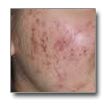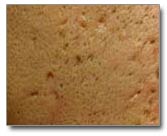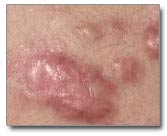The end result is dependent on
- Factors Relating To The Trauma Itself – (eg a clean-cut sterile surgical wound vs a zig-zag or stellate wound, with tissue necrosis resulting from an infected injury).
- Host Factors (the body’s response) which could consist of hyperpigmentation, tethering or dimpling of the skin, neovascularization (the growth of tiny new capillaries)– giving the scar a pink appearance, or a hypertrophic reaction (tissue overgrowth) leading to a keloid scar
Acne Scarring
Hyperpigmentation

Acne Scarring
A common response to the inflammatory component of acne, this can be treated with skin lightening agents such as kojic or azelaic acid, or glycolic /salicylic/light TCA peels, or *pulse dye laser. Contraindications to chemical peels would be the use of Accutane within the preceding year, pregnancy, previous allergy or sensitivity; active dermatitis; and in the case of TCA – darker skin types. A series of peels will be needed 2-4 weeks apart. Fraxel Dual laser 1550/1927 can also be used.
*As of the time of writing, we currently do not have PDL;
Stretch Marks
Otherwise known as striae, these red/purple/pink indented streaks are often seen on the abdomen, buttocks, thighs, breasts or upper arms following rapid weight gain/loss or in the latter third of pregnancy and beyond. They are due to stretching of the dermis, in the setting of decreased fibroblast activity which results in inadequate elastin and collagen production to maintain skin elasticity, and are influenced by familial, genetic or hormonal factors.
Outside of pregnancy or rapid weight gain, they can be seen in puberty, with muscle growth, in genetic conditions such as Marfan’s or Ehlers-Danlos syndromes, or disorders affecting the adrenal glands (Cushing’s syndrome).



